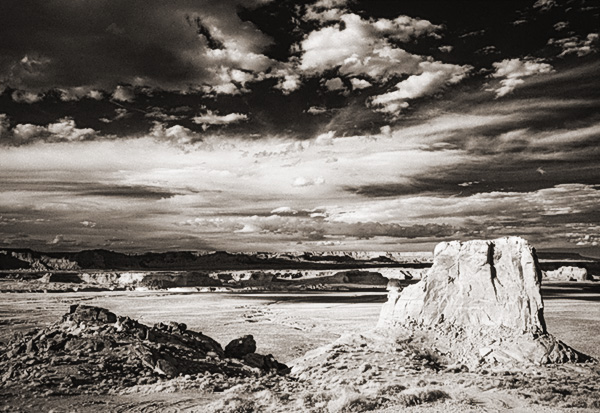Stud Horse Point Infrared Photography – Page Arizona
Infrared imaging can add interest to a scene that otherwise would be OK but rather mundane. I have a Lumix G6 that I had converted to IR by LifePixel. It’s great to take an older camera that isn’t getting much use and have it converted to Infrared. Or if you don’t have an older candidate that will work you can but up a used camera and have it repurposed.
But why is it good Bob?
Some times of day are just not conducive to solid imagery. Usually, midday is less than ideal for making photos and that is when IR photography can shine especially when there are clouds and or trees in the scene. Here was an example where I wasn’t thrilled witht the lighting. We were hoping for great color in the sunset. You know how that goes. All looks good then falls flat. Rather than come home empty handed I kinda like the outcome of these.
 Outside Page, Arizona – Stud Horse Point
Outside Page, Arizona – Stud Horse Point
When capturing IR photos I tend to shoot in RAW + jpeg with the camera set to black and white. The black and white allows me to get a better sense of how the scene will render as the RAW image will come in with a magenta cast. I also bracket exposures as the camera’s meter and histogram are still ‘thinking’ in full spectrum color mode.
I picked the RAW images I wanted to process. Then output them to Photoshop and added some dodging and burning. Then took the image to NIK ColorFX Pro 4 to add some Glamour Glow and a little grain to emulate the look of film IR. As a final step, I evened out the overall color and added a light sepia tone over the image using a Hue/Saturation action.
Yours in Creative Photography, Bob







Great job Bob. I really like how IR renders the sky. I like both images but I think I might like the second one even more – love the light (dodging and burning, I assume).
When you convert to B&W are you using a yellow or red filter or just neutral? I like how the blue sky is rendered dark, is why I ask.
Leroy when I convert in this case I’m using ACR and using color sliders. You can also go to the convert to greyscale and use the individual color sliders to darken or lighten specific colors. Sometimes I’ll double or triple process images if I’m not getting the tones I want then blend those together with Layers and masks. Since I shoot bracketed exposures I also sometimes pick different exposures for different areas and blend those together…